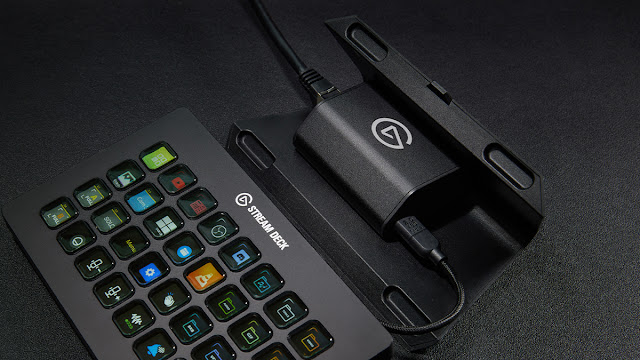Elgato anuncia o "Stream Deck Everywhere"
Foi no evento Computex 2025 que a marca nos apresentou o Stream Deck Everywhere, um novo conceito que tem como alvo usarmos o Stream Deck em, bem, tudo? São quatro novas inovações nesta estratégia de o colocar em diferentes situações ou até mesmo piscar o olho a toda uma quantidade de utilizadores novos, através de uma customização e versatilidade no produto, tornando-se mais próximo de uma plataforma do que um dispositivo.
O principal destaque para este Stream Deck Everywhere vai para os Stream Deck Modules, uma versão barebones do Stream Deck que praticamente nada tem a não ser o seu chassis. Disponível em três diferentes variantes com 6, 15 ou 32 teclas, vêm em alumínio resistente e entradas para os poderem ligar a "qualquer lado".
Através da sua versatilidade modular, onde podemos colocar estes novos dispositivos em qualquer lugar, podemos ter o controlo de algo que não está fixo a uma secretária. Um exemplo prático é podermos controlar luzes ou colunas de som, através de um Stream Deck colocado numa sala ou espaço onde fará sentido. Claro que será sempre necessário estar ligado a um dispositivo que corre o software da Elgato que podemos encontrar em quaisquer outros produtos da mesma gama.
Também nesta proposta temos o Network Dock que se conecta aos Stream Deck, dando controlo aos seus utilizadores muito além do seu uso na tradicional secretária. Através de uma ligação online podemos controlar tudo ligado diretamente ao dispositivo. Ao nível de software temos o Virtual Stream Deck, uma versão digital do Stream Deck que traz a tradicional costumização do produto para o nosso ecrã, controlado de igual modo mas através de um click no nosso ecrã, na posição que assim entendermos. Por último temos as Scissor Keys, uma nova experiência tátil para quem procura uma variante para as típicas teclas do Stream Deck. Uma alternativa mais precisa, rápida e responsiva aos switches atuais do produto.
Tanto os Stream Deck Modules como a Virtual Stream Decks aumentam o potencial uso do tradicional Stream Deck, pensando não só no hobby associado a videojogos (e fazer stream dos mesmos), mas também a nível de produtividade e até mesmo coisas típicas do quotidiano.
Segue-se o comunicado oficial (em inglês), para que não falte nada.
Elgato Unveils "Stream Deck Everywhere" Strategy at Computex
Elgato, a leading provider of content creation tools and a subsidiary of Corsair ® (NASDAQ: CRSR), is expanding the Stream Deck ecosystem in exciting new directions. At this year's Computex, the company will unveil four groundbreaking innovations under its new "Stream Deck Everywhere" strategy, aimed at bringing powerful, customizable control to more users and workflows than ever before.
"Stream Deck has become a must-have for creators, but until now, many people beyond the creator space lacked access to its potential," said Julian Fest, General Manager at Elgato. "With these launches, we're opening up Stream Deck to a world of new users, from developers and DIY builders to manufacturers seeking a field-proven interface for their products. Because Stream Deck isn't just a device—it's a platform."
Stream Deck Modules: DIY and integration-ready
First up is Stream Deck Module, a barebones version of the lauded consumer product that enables hobbyists, entrepreneurs, and manufacturers to embed the iconic technology in their projects, instead of allocating months or even years to developing a control interface from scratch. Available in 6, 15, and 32-key variations, the module comes housed in a durable aluminum chassis that's ready to drop straight into a custom mount, machine, or product.
Like its retail counterparts, Stream Deck Module is compatible with Stream Deck software and third-party apps, while comprehensive documentation removes the guesswork for makers and manufacturers to bring their big ideas to life—faster, smarter, and without compromise.
Network Dock for Stream Deck: Untethered control
Elgato's new Network Dock unlocks wired Ethernet connectivity for Stream Deck devices, empowering users to extend their control surface beyond the desktop to custom installations, remote stations, and more. Whether mounted to a desk or slotted into Stream Deck XL's stand, the dock supports both PoE and non-PoE networks, while IP configuration is easily handled directly on-device. It's another major step toward unlocking Stream Deck's full potential—anywhere it is needed.
Virtual Stream Deck: Control at the tip of your cursor
Perhaps the most transformative of all, Virtual Stream Deck (VSD) is a software-only version of Stream Deck that brings powerful, customizable control to any screen. Users can create fully interactive control pads anywhere on their desktop—fixed in place for quick access or summoned with a mouse click or hotkey. It makes Stream Deck more accessible than ever, putting Elgato's iconic platform in every corner of a user's workspace. Initially launching exclusively for owners of Stream Deck hardware and select Corsair peripherals, like the Xeneon Edge and the Scimitar Elite WE SE Mouse, Virtual Stream Deck will soon roll out to more devices, unlocking intelligent control across touchscreens, mice, keyboards, and beyond.
Scissor Keys: A new tactile experience
Rounding out the announcements is a scissor-switch key variant of Stream Deck MK.2, a faster, crisper alternative to the iconic membrane design. With shorter travel and sharper actuation, these new switches offer enhanced speed and precision for high-frequency tasks and quick hands. The tighter, more responsive feel also lends itself to typing-style interactions, paving the way for new use cases that benefit from rapid, multi-layered input and control.
Stream Deck ecosystem: From hardware to everywhere
Stream Deck has grown from a creator tool into a powerful platform—one that adapts to any workflow, scales with ambition, and invites innovation across industries. This new wave of launches marks a shift: control is no longer confined to a device or a desk. Elgato is expanding what Stream Deck can be, and where it can go. With modular hardware, open documentation, and deeply integrated software, makers, businesses, and creators now have the freedom to build smarter workflows, reimagine what control looks like, and where it belongs.



















